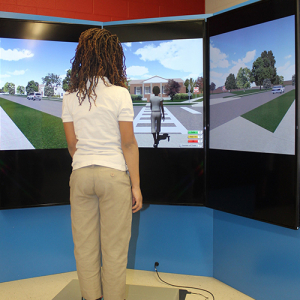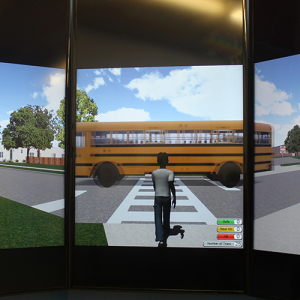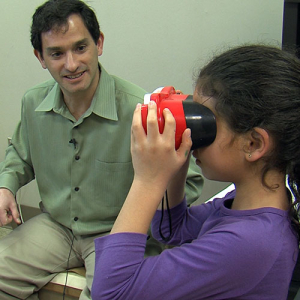Pedestrian Safety
-
Child learning to cross the street in mobile virtual pedestrian environment.
-
Screenshot of virtual pedestrian environment.
-
Child using smartphone-based virtual pedestrian environment, under Dr. Schwebel’s direction.
In a single year, over 6,300 American pedestrians are killed and nearly 200,000 others injured. A disproportionate portion of injured pedestrians are children. Globally, an estimated 514,000 pedestrians die annually and over one-third of traffic-related deaths are to pedestrians rather than vehicle occupants or other road users. Injury rates worldwide tally well into the millions and often involve lifelong disabling trauma.
Traditionally, child pedestrian safety campaigns relied on classroom education or one-on-one streetside training with an adult. Such training was sometimes successful but always highly laborious and expensive. In collaboration with Digital Artefacts, the UAB Youth Safety Lab uses virtual reality (VR) to teach children pedestrian safety. Virtual reality is engaging and fun. It also can be tailored to children’s ability level, delivered with minimal adult supervision, and allows children to engage in the repeated practice necessary to develop complex cognitive-perceptual skills required to be a safe pedestrian.
We began with a large VR placed in our laboratory, and progressed to a more mobile VR that was moved to schools and community centers and an internet-based platform. We are currently testing delivery of the VR via mobile phone, a strategy that could permit broad implementation and dissemination of a successful intervention program globally.
Sample Publications
- Schwebel, D. C., Hasan, R., Griffin, R., Hasan, R., Hoque, M. A., Karim, Y., Luo, K., & Johnston, A. (2021). Reducing distracted pedestrian behavior using Bluetooth Beacon technology: A crossover trial. Accident Analysis and Prevention, 159, 106253.
- Fobian, A. D., Rouse, J. B., Stager, L. M., Long, D., Schwebel, D. C., & Avis, K. T. (2020). The effects of sleep deprivation and text messaging on pedestrian safety in university students. Sleep, 43, zsaa057.
- Schwebel, D. C., McClure, L. A., & Porter, B. E. (2017). Experiential exposure to texting and walking in virtual reality: A randomized trial to reduce distracted pedestrian behavior. Accident Analysis and Prevention, 102, 116-122.
- Schwebel, D. C., Wu, Y., Li, P., Severson, J., He, Y., Xiang, H., & Hu, G. (2018). Evaluating smartphone-based virtual reality to improve Chinese schoolchildren’s pedestrian safety. Journal of Pediatric Psychology, 43, 473-484.
- Schwebel, D. C., Combs, T., Rodríguez, D., Severson, J., & Sisiopiku, V. (2016). Community-based pedestrian safety training in virtual reality: A pragmatic trial. Accident Analysis and Prevention, 86, 9-15.
- Schwebel, D. C., McClure, L. A., & Severson, J. (2014). Teaching children to cross streets safely: A randomized controlled trial. Health Psychology, 33, 628-638.
- Davis, A. L., Avis, K. T., & Schwebel, D. C. (2013). The effects of sleep restriction on adolescents’ pedestrian safety in a virtual environment. Journal of Adolescent Health, 53, 785-790.
- Stavrinos, D., Byington, K. W., & Schwebel, D. C. (2009). The effect of cell phone distraction on pediatric pedestrian injury risk. Pediatrics, 123, e179-185.



